Michigan vegetable crop report - June 23, 2022
The rollercoaster weather has created conditions supportive of oomycete pathogens like Phytophthora and downy mildew, and hot/dry weather-loving insects like thrips, mites and aphids.
Weather
Watch Jeff Andresen’s weather update here.
This spring has been a roller coaster, even more than normal. Roughly every week temps increased to near record-breaking levels before cooling again. Why is the roller coaster even hillier than normal? It’s because the jetstream has been more amped up than is typical. A shift from the trough to the ridge has created our ups and downs. Most of the state is several days to a week ahead of normal for degree-day accumulations.
For the past week, temps were 2-4 degrees Fahrenheit above-normal. The past week was relatively dry, with most of the state seeing 0.5 inches or less.
The forecast calls for:
- Mostly sunny, dry, and cooler Wednesday and Thursday.
- Fair and very warm Friday and Saturday. Scattered showers and thundershowers possible late Friday, Saturday, and early Sunday.
- Fair, dry, and cooler early next week. Daytime temperatures in the upper 70s far to mid 80s Wednesday, falling to the 70s to low 80s Thursday, increasing back to the 80s to near 90 Friday into the weekend. Lows in the 50s Thursday warming back to the 60s this weekend.
- Precipitation is forecast to reach only trace to low amounts for the next week.
- Potential evapotranspiration, crop water demand continue at above normal rates.
- Medium range guidance calls for cooler, more seasonable temperatures the last few days of June into early July.
The three horsemen of hot dry weather
With the continued cycles of hot and dry weather, it’s worth reading up on the three bugs that seem to thrive in these conditions, thrips, mites and aphids.
Crop updates
Asparagus
Harvest was expected to finish up by this Saturday in Oceana and Mason County as harvest comes to an end. Growers are applying herbicides this week as they shut fields down. With the heat coming, asparagus can grow quite quickly. Keep this in mind as the risk of injury from hormonal herbicides (2,4-D, dicamba) will increase if spears grow rapidly after the last mow or pick.
Remember that a little bit of air movement, but not too much, is good for minimizing risk of herbicide drift. Especially consider this as you shut down full-season fields in the neighborhood of young ones that have already ferned out. Inversions happen in the evening and can persist through early morning, and create the opportunity for volatile herbicides to move long distances. A little bit of wind in the morning signals some mixing is going on in the atmosphere, which is a good thing!
Michigan State University Extension attended the International Asparagus Symposium in Spain last week. Attendees hailed from the United States, Japan, Spain, Germany, Australia, the Netherlands. Mexico, Peru and New Zealand. Look for more “in depth” analysis to come, but for now here are a few highlights.
Organic soil amendments. A forward thinking UK farm-Cobrey Farms-has hosted a large, multi-acre trial looking at soil management. UK growers have been on the hunt for good soil management practices that alleviate between-row compaction and facilitate drainage, a problem with their tillage system, rainy climate and heavier soils. As part of this effort, they looked at compost application; compost application to these established fields significantly increased yield, but they don’t know why! The study was very well executed and the yield increase was large enough to bear a look here in the United States. More information is needed on the type of compost that was used, and of course we’d need to see if the effect is reproducible in Michigan conditions.
Annual asparagus production. Just like for annual strawberries, researchers in Japan and Utah have been looking into annual asparagus production. Basically, crowns or transplants are planted at very high density in spring, and grown for one year. The following spring, asparagus is harvested and… that’s it. The goal is to get a more rapid payback without incurring disease, insect, pest and weed management costs. This can be done in the soil, but also in large plastic bags, pots or beds with coir or other soilless media in a tunnel or greenhouse (for an early crop). Varieties with thick spears are helpful.
Spanish production. Spain produces white asparagus in one area, and green varieties in the south. One of our presenters reported Spain is actually the 5th largest producer in the world. We visited the Granada area, in the heart of green production. The area is very dry, with alkaline soils (pH of 8 at times). All the asparagus we saw was trickle irrigated. Some plants showed Phosphorus deficiency due to the high soil pH; one of the German fertility researchers noted it’s the only place she has ever seen this. The packhouse was interesting to visit. The asparagus was cut in the field and rubber banded in large bundles, which were then placed upright into a few inches of water in large containers (apparently for quality). The containers are stacked so they can be moved around via forklift. The bundles are then cut and placed on the line in the packhouse. Different diameter classes were being sorted and sold. Select diameters were bundled into a wrapper on the bottom that bore the company logo and origin. It was an interesting way to provide some marketing info, beyond what can fit on a rubber band. Of course, it required more effort: Some staff were dedicated to preparing these wrappers with stickers, which I assume were for traceability.
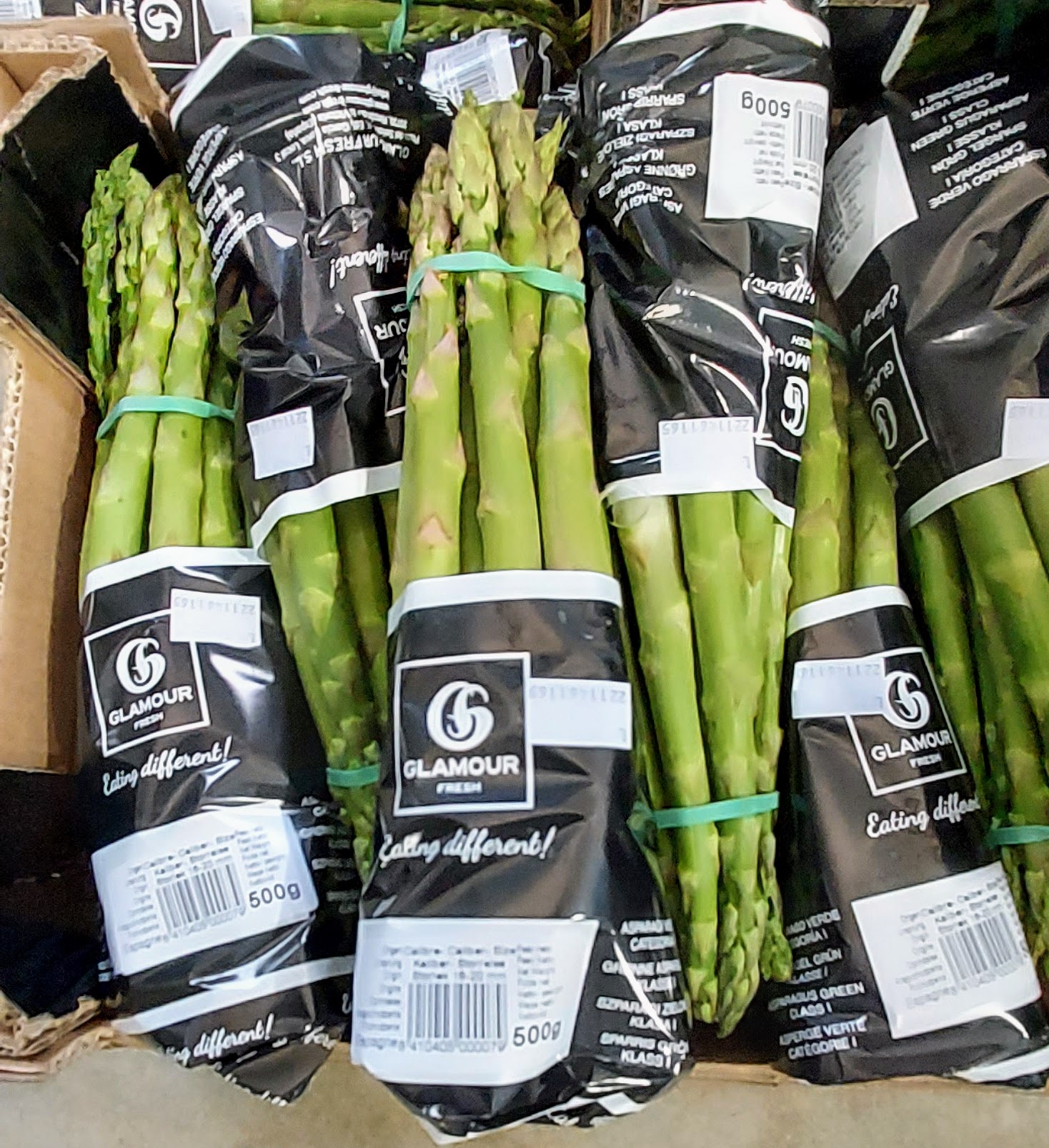
Creating locally unique products. Locals in the Granda area have selected “land races” specific to that region. These are apparently selected from wild-growing populations, and include a naturally occurring purple variety. At least one of these varieties-”Huetor de Tajar” has a “Protected geographical indication,” which I believe means only asparagus from that region can bear that name. It is kind of like a “Vidalia” onion or Champagne. On the same note, it was interesting to talk to folks familiar with the German industry. Based on our conversations (not research!), German consumers are very loyal to white German asparagus, but less so for green varieties, where country of origin may be less important. It is interesting to think about creating traditions that tie people to a local product, and marketing them.
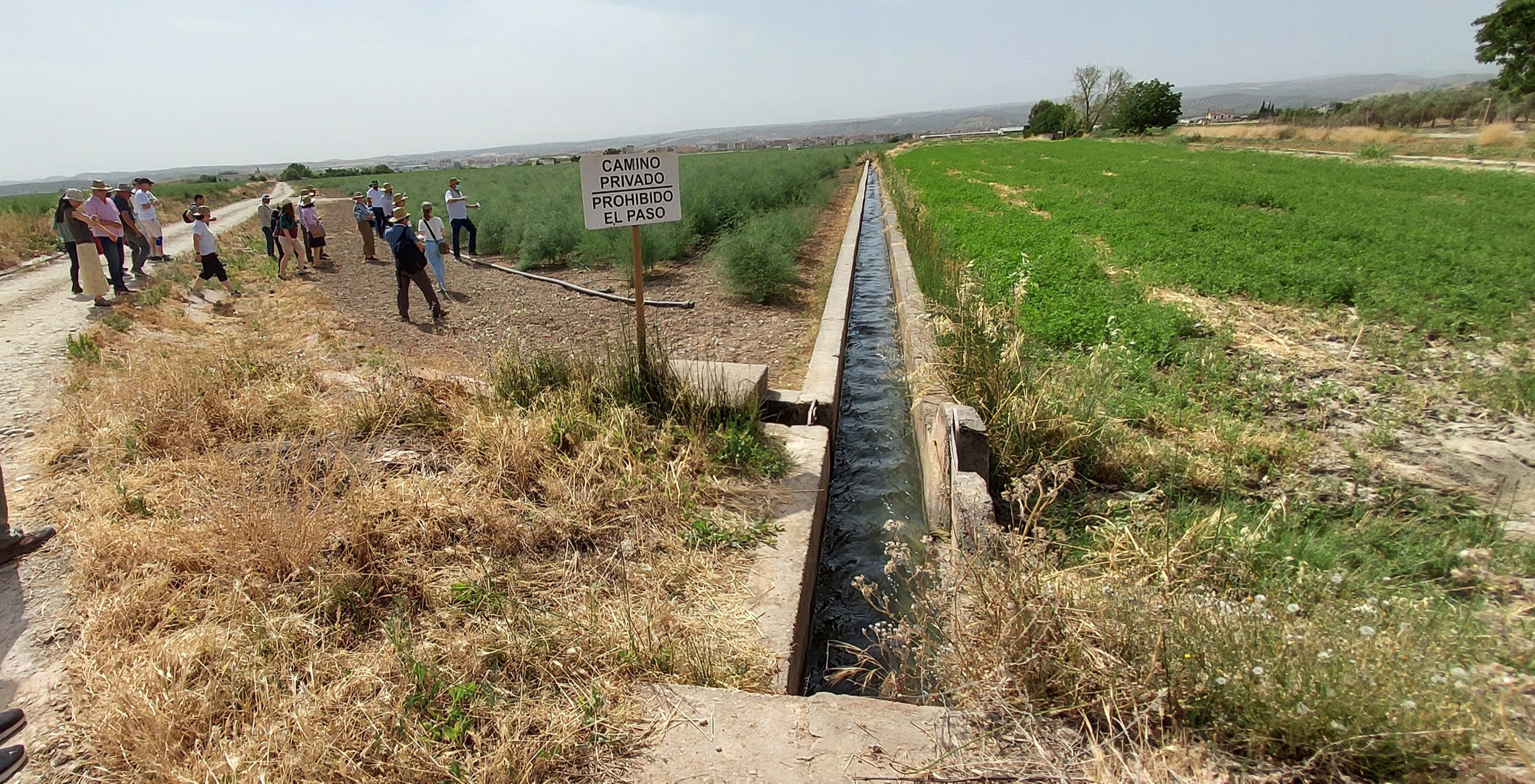
Labor, labor, labor. Both at this symposium, and the last one in Germany, it’s apparent that labor is the main cost and limiting factor in asparagus production, no matter where you go.
Mechanical harvesting and making changes where you can. High labor costs could continue to drive us towards mechanical harvesting but… there was an interesting contrast on my journey: A very nice periodical called “Asparagus World” (worth getting if you can) had a headline “How to be ready for the robots.” It was focused on preparing for use of mechanical harvesters for white asparagus. Reading it, it seems like it’s time to take a number for a machine. But talking with German researchers yielded a different story. Based on their experience, harvesters to date are very expensive, and not as selective as desired. Instead, the most widely used machines are harvest aids, which lift the plastic mulch that covers the white beds as a rider travels over the top and cuts the asparagus. This innovation was supported by labor studies, which looked at all the motions of harvest and identified inefficiencies. These changes were doable and cut down on “hours per pound” significantly.
Carrots and celery
Leafhoppers were present in two carrot fields we swept Monday, in Oceana and Mason County, but so far infectivity has been low. Some growers have already applied Asana (a.i. esfenvalerate) with their weed spray, while others have not. Keep an eye out for reports from this week’s samples.
Consultants report that leafhoppers are present at not-too-crazy numbers in celery as of early this week. Aphid colonies have not been found on plants to date. Celery leaf tier moths were just starting to fly. This pest is mostly an issue when high temps drive caterpillars down from the canopy into celery hearts. Tarnished plant bug is also present in some locations. Overall, pests are present in manageable numbers to date.
Cole crops
Peak activity of the early summer generation of cabbage maggot flies could begin in the next week, based on weather at the Allegan Enviroweather station. It could happen soon after that in locations near the Fennville, Hudsonville, and Grant Enviroweather stations. It will be important to protect susceptible root crops from damage when and where possible. Read more about this in “Controlling cabbage maggot in turnips with the Lorsban ban” from Michigan State University Extension.
Cucurbits/Pickles
I was reminded this week of the utility of a rotary hoe this week. Most processing growers in west central Michigan are familiar with this implement, which is also known for its decrusting ability. Growers run a rotary hoe over fields once squash is up to flick small weed seedlings out of the soil. It can be helpful for winter squash, for example. Doing it two days in a row, and offsetting where you start, can be helpful to get at the weeds from a different angle. In past years, one grower I know described it as a job for teenagers: You get to drive fast! This can be followed up with whatever cultivation method you choose. One farm uses mainly a row cultivator, while another farm has also used an Eco-weeder to get between plants.
Downy mildew has been found as far north as New Jersey, but aerial spores were detected in Bay and Saginaw counties last week. It is time to start monitoring for downy mildew symptoms and to start using proven protectant fungicides before symptoms begin.
Phytophthora fruit rot on pickles continues to be a major threat for some Michigan growers. Effective fungicides must be applied so that they cover the fruit. Fungicides applied to the soil are not effective and do not limit the pathogen. Also, fungicides applied to the foliage are not translocated to the fruit. Banded applications of fungicides can be used to protect young plants. Fungicides applied with high amounts of water (30 gallons) are more likely to penetrate the plant canopy and reach the fruit underneath. Previous MSU research to determine the timing of fungicide applications showed that fungicides must be applied when the fruit are 1”, 3” and 5” in length. The days between these fruit growth stages can vary based on the weather. Although Phytophthora and downy mildew are both oomycete pathogens, the products used for their management vary.
Here are tip sheets for these oomycete pathogens, comparing and contrasting effective fungicidal options.
- Cucurbit Downy Mildew: Managing Cucurbit Downy Mildew
- Phytophthora: Managing Phytophthora on Cucumber
- Phytophthora: Managing Phytophthora on Summer Squash and Zucchini
- Phytophthora: Managing Phytophthora on Winter Squash and Pumpkin
- Phytophthora: Managing Phytophthora on Cantaloupe, Muskmelon and Watermelon
Onions
Onion thrips were present at low levels in two west central onion fields this week, with some growers making their second Movento application. Check out Cornell's thrips control guidelines for 2022. Check your onion thrips numbers and calculate how many you have per leaf to determine if you need an insecticide application. Here is a video on onion thrips scouting to help you figure out the average numbers of thrips and leaves in a field. It’s important to determine that you are above the threshold before making an insecticide application because if you apply too early, you will not have enough insecticide options left for later in the season. In most years, the first Movento application is usually necessary in the last week of June, and this year is lining up with this timeline.
Early season weather has caused variable stand and maturity, depending on the timing of planting versus wet/cold periods. But onions are growing well now.
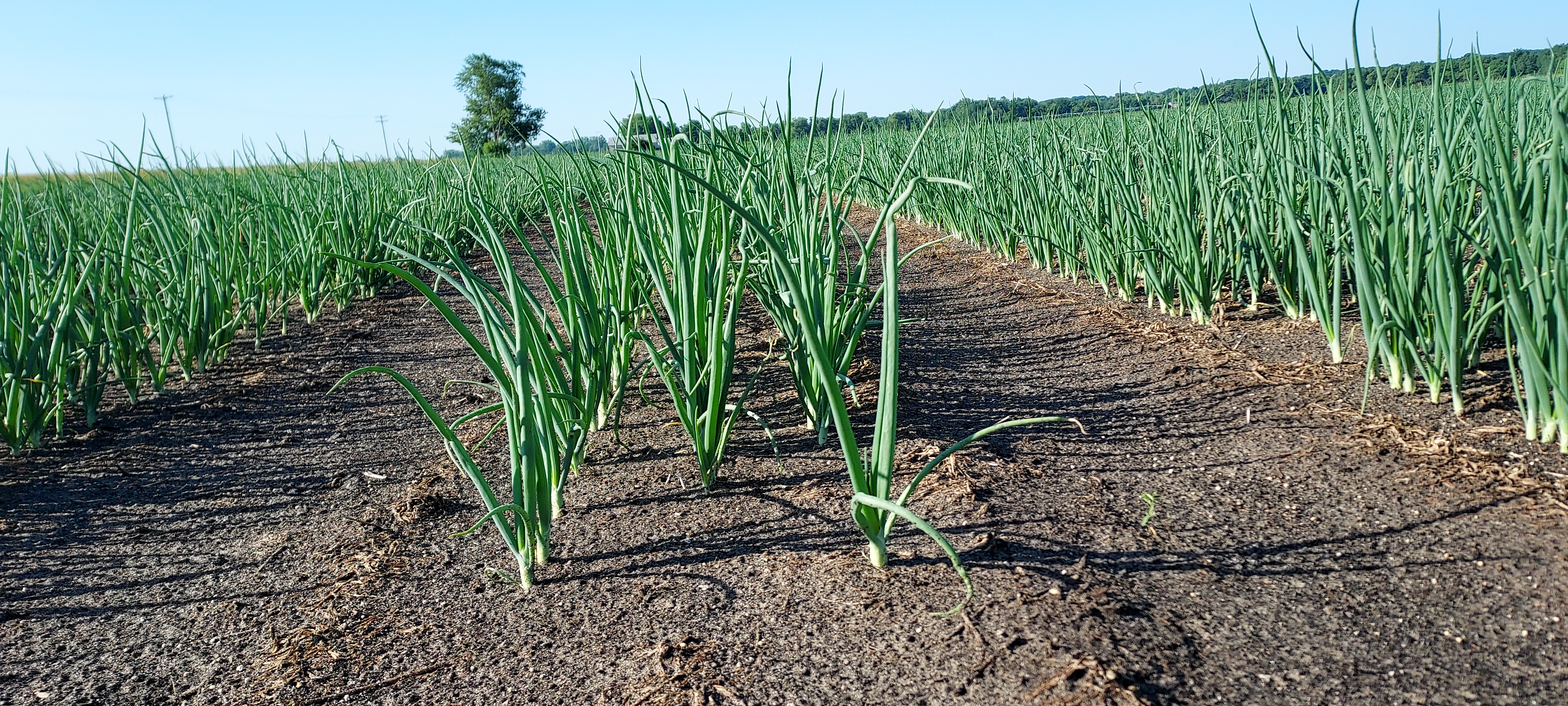
Spots and blights on the leaves can get in the way of good onion growth. In Michigan and other eastern production regions, producers wage a yearly battle to protect onions from various foliar diseases. Purple blotch used to be a common disease of onion leaves in the northeast U.S. but Stemphylium leaf blight has now become the most formidable opponent for many onion producers. Stemphylium leaf blight is caused by a fungal pathogen of the same name (Stemphylium vesicarium).
Early symptoms of Stemphylium leaf blight can be difficult to diagnose. Tip burn may be associated with herbicide damage but can also be a first symptom of disease. The brown spots of Stemphylium leaf blight are small at first but increase in size, extending down the leaf. These elongated lesions can appear similar to symptoms of bacterial stalk and leaf blight. In healthy onions the oldest onion leaves die first. However, premature leaf death resulting in a mid-season loss of green leaf tissue is typical of Stemphylium leaf blight. Without healthy foliage, bulb size is reduced and so is total yield.
Many of the fungicides that were historically used to manage purple blotch do not adequately protect against Stemphylium leaf blight. Field research from Michigan State University has shown that the Stemphylium leaf blight pathogen is resistant to fungicides classified as strobilurins such as azoxystrobin, picoxystrobin, pyraclostrobin, and trifloxystrobin. On the other hand, Omega SC, Luna Tranquility SC, Miravis Prime SC, Tilt SL, and Luna Experience SC effectively limit Stemphylium leaf blight. Our research has also shown that fungicide programs to protect the onion’s foliage from Stemphylium leaf blight should begin when plant are young (by the 5- to 7-leaf stage) and include highly effective products at the front end of the season to prevent the pathogen from becoming too well established. Protecting the onion leaves early in the season helps to ensure that the plants have a fighting chance to reach maturity and achieve their full yield potential.
Peas/Beans
Field peas for processing are at various stages of bloom, and harvest has begun on some southwest Michigan farms.
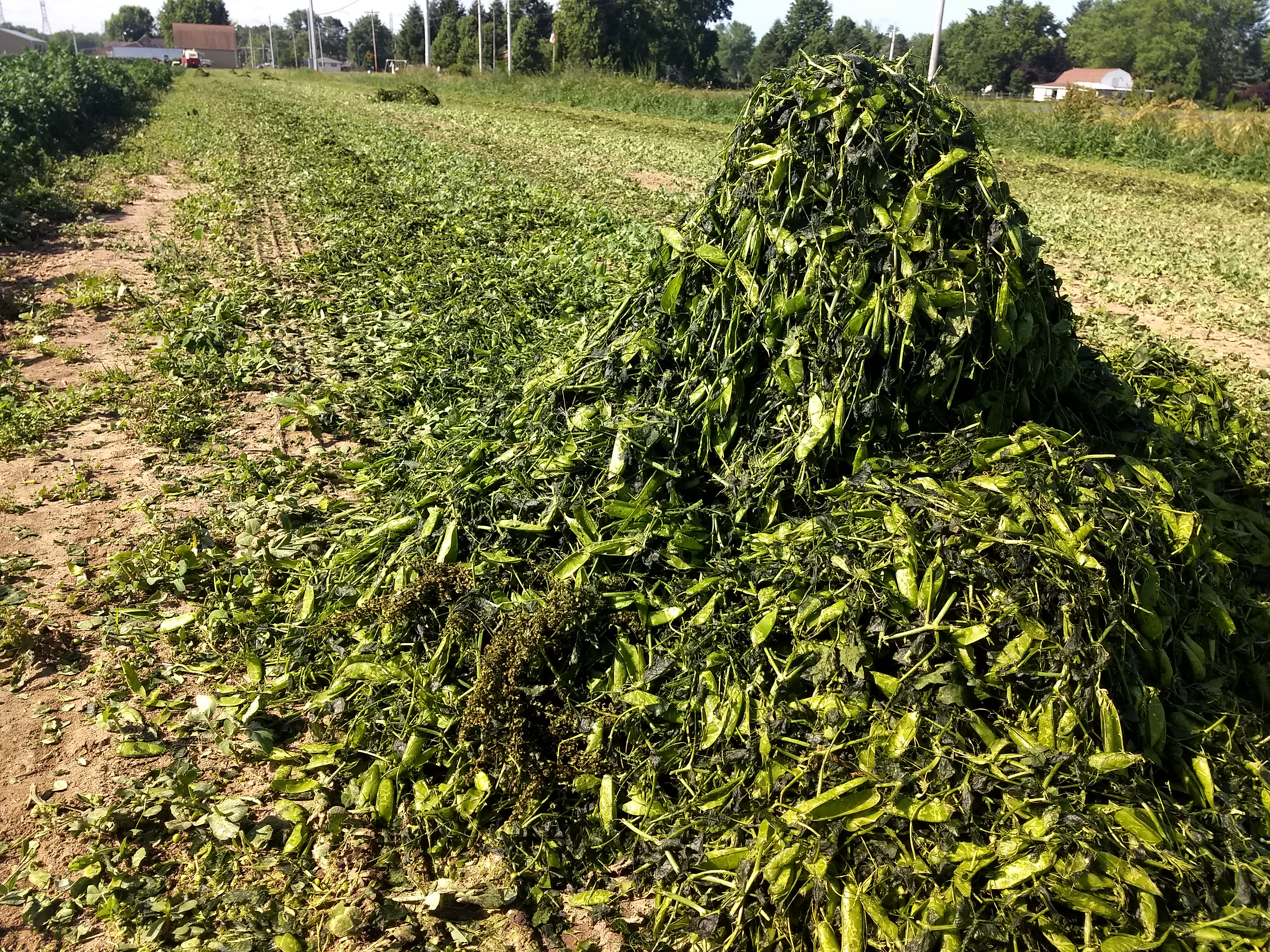
Fruiting vegetables
Early tomatoes are flowering in southwest Michigan and high nighttime temperatures have been a concern for pollination and fruit set. Tomatoes do not like temps in the high 70s at night. If you can get nice large pepper plants about a foot tall before flowering, then your yields will be maximized. This is achieved with proper transplant timing and pushing most of your nitrogen ahead of flowering.
TOM-CAST models for Alternaria early blight, Septoria leaf spot, and Colletotrichum anthracnose have reached their first threshold, or will be soon, across much of the state. When the threshold is reached, an application of chlorothalonil (Bravo) and azoxystrobin (Quadris) is warranted to protect plants and fruit against the three diseases listed above. Bacterial diseases are not predicted by this model and should be handled differently
Wilted pepper plants that have adequate moisture could be infected by Phytophthora capsici. Phytophthora was recovered from a pepper sample sent to the MSU diagnostics lab this week, and symptoms have been seen in SW Michigan. Fungicides are most effective when applied to the soil as a drench or through the drip irrigation. Previous MSU research showed that foliar applications of fungicide to pepper are not highly effective. Fungicides that can be used for soil application include ethaboxam (Elumin), mandipropamid (Revus), metalaxyl/mefenoxam (MetaStar, Ridomil Gold), oxathiapiprolin + mefenoxam (Orondis Gold), fluopicolide (Presidio), and oxathiapiprolin + mandipropamid (Orondis Ultra). Please note that in some regions of the state, mefenoxam cannot be effectively used due to the pathogen becoming resistant to this product.
Here is another tipsheet for this oomycete pathogen, including effective fungicidal options: Managing Phytophthora on Pepper.
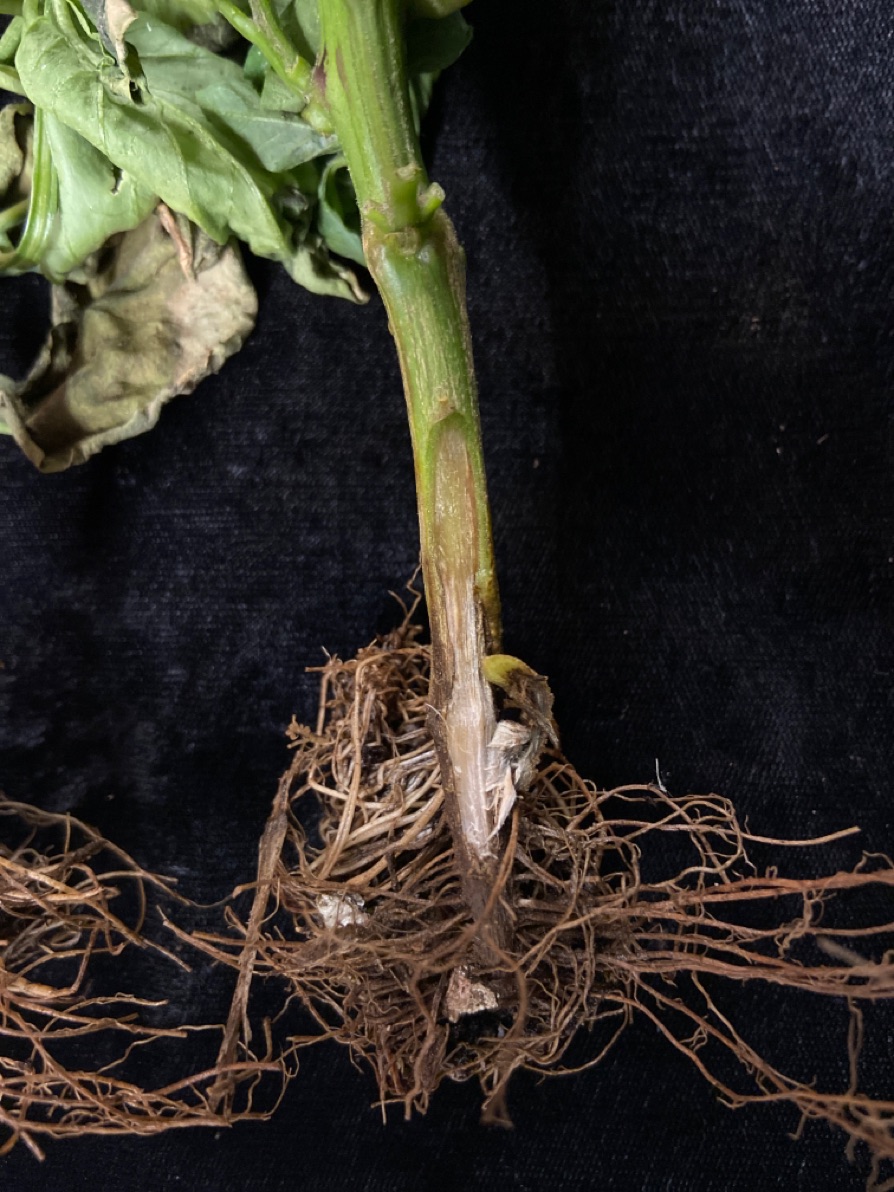
Colorado potato beetle larvae are feeding along with adults laying eggs.
Strawberries
Harvest continues. Maintain fungicide coverage to protect the leaves and help prevent fruit rots as fruit continues to ripen, especially with the heat. The heat, humidity and rain have shortened the season for some growers.
Events
- June 29: Weed Tour from 9:30 a.m. to 1 p.m. at the on-campus Plant Pathology Field Laboratory at 3735 N. College Road in Lansing.
- July 13: Hops Field Day from 10 a.m. to 2 p.m. at the on-campus Plant Pathology Field Laboratory at 3735 N. College Road in Lansing. The event features presentations on disease management, viruses, nematodes, insects and tips on brewing.
- July 19: Dairy Open House from 4:30 to 8:30 p.m. at the K. Kellogg Biological Station. The station is located at 3700 East Gull Lake Drive in Hickory Corners. Attendees can sample MSU ice cream, while participating in family friendly activities. Guests can also participate in a guided tour of the barn and learn about Michigan's agricultural landscapes. For more information, contact the station via email at pasture.dairy@kbs.msu.edu or call 269-671-2402.
- July 27: Viticulture Field Day at the Southwest Michigan Research and Extension Center. The center is located at 1791 Hillandale Road in Benton Harbor.
- Aug. 4: Potato Field Day from 8 a.m. to 3 p.m. at the Montcalm Research Center. The center is located at 4629 W. McBride Road in Lakeview. Presentation topics include sustainability, irrigation and potato storage management.
- Aug. 10: Turf Field Day at the on-campus Hancock Turfgrass Research Center. The center is located at 4444 Farm Lane, Lansing, MI.
- Aug. 11: Field Day and Pasture Walk at the Lake City Research Center. The center is located at 5401 W. Jennings Road in Lake City and works primarily in livestock management.
- Aug. 23: Plant Diagnostic Day at the Saginaw Valley Research and Extension Center. The center is located at 3775 S. Reese Road in Frankenmuth.
- Aug. 24: Blueberry field day at the Trevor Nichols Research Center. The center is located at 6237 124th Ave. in Fennville, Michigan.
- Aug. 25: 2022 Tile Drainage Field Day at 13000 Bird Lake Rd, Camden, MI.
- Sept. 8: Field Day at the Northwest Michigan Horticulture Research Center. The center is located at 6686 S. Center Highway in Traverse City and will highlight Michigan fruit advancements.
- Sept. 14: Mechanical Weed Control Field Day at the Southwest Michigan Research and Extension Center. The center is located at 1791 Hillandale Road in Benton Harbor.
This work is supported by the Crop Protection and Pest Management Program [grant no 2021-70006-35450] from the USDA National Institute of Food and Agriculture.



 Print
Print Email
Email

